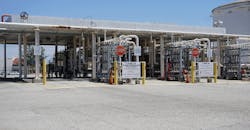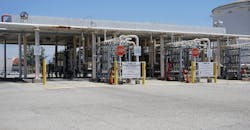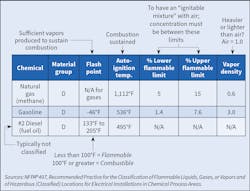How to Properly Apply Code Requirements for Hazardous Locations
Over the years, EC&M articles have addressed many topics when applying the rules for hazardous (classified) locations. Safety tips for working in hazardous locations, class and division basics, the zone classification system, intrinsically safe systems, detailed information on Code installation requirements, and requirements for commercial garages and fuel-dispensing facilities can all be found in recent issues.
For those who are not frequent users of the information in Chapter 5 of the National Electrical Code (NEC), the hazardous location topics can be confusing, if not intimidating. Unraveling terminology unique to hazardous locations, knowing what information is available in the NEC, and how to locate that information are the first steps in properly applying the Code requirements.
The NEC Chapter 5, Special Occupancies, provides specific requirements for hazardous locations. The NEC is designed to meet the purpose of Sec. 90.1, “… practical safeguarding of people and property from the hazards arising from the use of electricity.” It only makes sense that in occupancies containing materials such as flammable gases and vapors, coal dust, grain dust, or ignitable cotton fibers and other such materials, special rules must apply to safeguard people and property. Whether it is heat created by electrical equipment, or the commonly occurring arcs and sparks of operating contacts that could ignite certain materials, potentially catastrophic results must be avoided through proper NEC application.
Understanding the Terminology
The NEC allows for the use of one of two different methods of classifying hazardous areas. The Division System is used extensively throughout the United States and refers to the terms “Class” and “Division.” Class refers to the type of material that could be ignited, while Division refers to the likelihood of that material being present. The Zone Classification System first appeared in the 1996 Edition of the NEC while the Division System goes back 100 years. The Zone System is based on standards of the International Electrotechnical Commission (IEC) and offers an alternative to the Division System. Canada has changed the Canadian Electrical Code (CEC) in its most recent edition to move toward the Zone System.
A hazardous (classified) location is a specifically designated area where the possibility of fire or explosion exists because of the materials that are handled or simply may be present. These may include flammable or combustible gases or vapors, combustible dust, or easily ignitable fibers or flyings. The terms “hazardous” and “classified” are interchangeable when discussing NEC requirements.
Article 500, Hazardous (Classified) Locations, Classes I, II, & III, Divisions 1 & 2 becomes the introductory textbook to understanding the Division System of classification, the various materials, protection techniques, and equipment used in these locations. However, as a Codebook, it does not explain the definitions and terminology used to form the basis of its requirements. For example, Sec. 500.5(B) defines Class I locations as those “… in which flammable gases, flammable liquid–produced vapors, or combustible liquid–produced vapors are or may be present in the air in quantities sufficient to produce explosive or ignitable mixtures.” To break down and understand this statement in the Code, consider the following three examples of Class I materials.
Natural gas (primarily methane) will ignite and sustain combustion at approximately 1,112°F. This is called its Autoignition Temperature, which is the minimum temperature to cause self-sustained combustion of a solid, liquid, or gas.
Gasoline is classed as a flammable, liquid-produced vapor. Flammable liquids are those that will produce enough vapors at less than 100°F to sustain combustion when mixed in the proper concentration with air. The flashpoint is the specific temperature at which this quantity of vapors is produced. For gasoline, the flashpoint is -46°F. To ignite the vapor/air mixture, enough heat energy must be applied to raise its temperature to 536°F. Thus, 536°F is the autoignition temperature of gasoline. As more heat is produced from the burning vapors, it will continue to heat the liquid gasoline, causing more and more vapors to be released. The process is then self-sustaining, and, as we know, the results produced can be catastrophic as fire and rapidly expanding vapors produce explosive effects.
Diesel fuel (fuel oil) is a combustible liquid. Combustible liquids will not produce enough vapors to combine with air and ignite unless they reach 100°F or above. Diesel fuels will have different characteristics depending upon whether it is #1 Diesel (1-D) or #2 Diesel (2-D). Additionally, different blends will have somewhat different characteristics. Depending upon the blend, #2 Diesel will give off enough vapors to become ignitable and sustain combustion between 133˚F and 205°F, (the #2 Diesel flash point). Once produced, those vapors will ignite and sustain combustion if they reach 495°F, (#2 Diesel autoignition temperature). See Fig. 1 for a comparison of the properties of natural gas, gasoline, and diesel fuel.
Article 500 defines Class II locations as those “that are hazardous because of the presence of combustible dust.” Combustible dust is dust that is 500 microns (0.02 inches) or smaller and will present a fire or explosion hazard when dispersed and ignited in the air.
Class III locations are those that are hazardous because of the presence of easily ignitable fibers or flyings. However, they would not likely be in sufficient quantities to produce ignitable mixtures. Ignitable fibers and flyings are not well defined by the NEC. Fibers from cotton, rayon, jute, hemp, and oakum are typical of these materials. While presenting a fire hazard, especially flash fires, Class III materials are generally not considered an explosion hazard.
Division refers to the likelihood of the material being present in dangerous quantities. Within each Class, there are two divisions: Division 1 and Division 2. Article 500 spells out in detail the requirements for Division classifications.
Material Groups are based on the properties of the material. For example, in Class I locations the Group “A” material is acetylene, which is a lighter-than-air gas that will sustain combustion at 58°F. A Group “B” material would be hydrogen. The remaining classified gases and vapors fall under Groups C and D. Groups E, F, and G identify combustible dust based on their characteristics. There are no Material Groups for Class III.
NEC Articles for Hazardous Locations
The NEC Articles for Hazardous Locations are found in Chapter 5, Special Occupancies. The information in this chapter modifies or supplements information found in Chapters 1 through 7 of the NEC. For example, an Article on hazardous locations may allow for the use of Metal-Clad Type MC-HL cable in certain applications. The rules for supporting and securing, the limitations on bend radius, and so on, are found in Art. 330, Metal-Clad Cable, Type MC — not in the hazardous locations Article that permits their use.
As previously mentioned, Art. 500, Hazardous (Classified) Locations, Classes I, II, & III, Divisions 1 & 2 is the one Code Article to learn many of the basics of hazardous locations. For example: What constitutes a location as to its Class and Division? What are examples of these locations, and what materials are typical of these areas? What are the 11 different acceptable protection techniques for hazardous locations? What markings are required on equipment? What are the surface temperature limitations on this equipment? What are the requirements for conduit threading? What are the special requirements for optical fiber cables installed in hazardous locations? All of the answers to these questions can be found in Art. 500.
Understanding how Articles 501 through 503 are formatted makes working within them much easier. See Fig. 2 to note the consistency of information located within these Code Articles.
Articles 511 through 517 cover specific occupancies. Here, much of the work of classification of areas and installation requirements have already been determined for these commonly found occupancies. See Fig. 3 for a list of the Chapter 5 Articles specific for Hazardous (Classified) Locations.
Additional standards beyond the NEC provide guidance for classification and other requirements for hazardous locations. For example, NFPA 820 Standard for Fire Protection in Wastewater Treatment and Collection Facilities provides classification information on specific locations within these facilities.
The American Petroleum Institute (API) publishes API 500 Recommended Practice for Classification of Locations for Electrical Installations at Petroleum Facilities Classified as Class I, Division 1 and Division 2. Referring to additional documents such as these can quickly answer many questions regarding the classification of areas at certain locations.
In Summary
For those who do not perform electrical work in locations that have been classified as “hazardous,” much of Chapter 5 of the NEC is misunderstood and can quickly be forgotten after the licensing exam. Yet, understanding basic terminology and what information can be found in Chapter 5 helps unravel the complexity of the rules for hazardous (classified) locations. Simplifying terms removes confusion about this topic and makes it much easier to answer questions and solve application issues. Following the NEC rules for hazardous locations consistently ensures safe installations.
Barnett is a certified electrical safety compliance professional (CESCP). He can be reached at [email protected].




